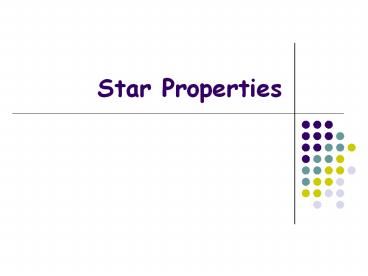Star Properties
1 / 38
Title: Star Properties
1
Star Properties
2
Apparent Magnitude
- System of Hipparchus
- Group of brightest stars 1m
- Stars about ½ as bright as 1m 2m
- Stars about ½ as bright as 2m 3m
- Naked Eye Limit 6m
3
Apparent Magnitude
- 19th century photographers learn how eye responds
to light (Pogson) - Doubling the brightness is not perceived as a
doubling by the eye - Eye response is logarithmic
- Ratio of 100 in brightness corresponds to a
Difference of five magnitudes - Dm of 5 ? 100X in light
- Dm of 1 ? 2.512X in light
4
Some Apparent Magnitudes
- Sun -26.8
- Full Moon -12.6
- Venus at brightest -4.4
- Sirius -1.5
- Naked Eye Limit 6.0
- Faintest Objects 30.0
- Hubble
5
Learning the Brightness
- Is a star bright...
- Because it really is a bright star?
- Because it is close to the Earth?
- Stellar brightness depends on
- Luminosity
- Distance
6
Measuring Distance
- Stellar Parallax
7
Stellar Parallax
Parallax
1 AU
8
Measuring Parallax
1 arcsec
1 AU
1 parsec
9
Stellar Parallax
When p is measured in arcsec and d is measured in
parsecs
One parsec 206,265 AU 3.26 light years
10
Stellar Parallax
- Nearest star to Sun (largest parallax)
- a Cen p 0.7 arcsec
- Limit of accurate parallax
- ? 200 pcs (angles of 0.005 arcsec)
- Hipparcos satellite (120,000 stars measured to
0.001 arcsec)
11
Absolute Magnitude
- The magnitude a star would have at 10 parsecs
from the Sun. - The apparent (m) and absolute (M) magnitudes of a
star at 10 pcs are the same. - M, m, and d are related. Knowing two allows you
to compute the third.
12
Putting the Pieces into Place
Ejnar Hertsprung 1911
Henry Norris Russell 1913
13
(No Transcript)
14
Luminosity Classes
I Supergiants II Bright Giants III Giants IV Subgi
ants V Dwarfs
15
(No Transcript)
16
Luminosity Class implies Size
- Consider the Sun and Capella
The Sun G2V M5
Capella G2III M0
17
Luminosity Class implies Size
- Equal sized pieces of each star are equally
bright - Capella is 100X brighter (5 magnitudes)
- Capella must have 100X as much area
- Surface area ? radius2
- Capella must be 10X larger than Sun.
18
Luminosity Class in the Spectrum
A3 Supergiant
A3 Giant
A3 Dwarf
19
Sun G2V Vega A1V Betelgeuse M1I
20
Which of these stars is hottest?
- Sun G2V
- Vega A1V
- Betelgeuse M1I
- Cant compare
21
Which of these stars is brightest?
- Sun G2V
- Vega A1V
- Betelgeuse M1I
- Cant compare
22
Which of these stars is smallest?
- Sun G2V
- Vega A1V
- Betelgeuse M1I
- Cant compare
23
Which of these stars is most distant?
- Sun G2V
- Vega A1V
- Betelgeuse M1I
- Cant compare
24
Spectroscopic Parallax
- Observe the spectrum and apparent magnitude of a
star - Classify the spectrum
Main Sequence
- Plot it on the H-R Diagram
- Read off the M
- From m and M compute distance
25
Color Index
12000 K
7000 K
26
Color Index
- Star Temperature mB mV .
- 1 12000 K 2.0 2.4
- 2 7000 K 3.0 3.1
- Color Index mB - mV B-V
- 1 B-V 2.0 - 2.4 -0.4
- 2 B-V 3.0 - 3.1 -0.1
27
Spectroscopic Parallax
- Can now get distances to any object whose
spectrum can be measured. - Limit ? 5000 pcs
28
Study Tools
- Review 1
- Review 2
29
The Advantage of Color Index
- Measures temperature just like Spectral Type
- Much easier to obtain
- requires two measurements of brightness
- spectral type requires getting the spectrum
30
Color-Magnitude Diagrams
Standard H-R Diagram
Color-Magnitude Diagram
31
Color-Magnitude Diagrams
- Useful for star clusters
- Can substitute mV for MV since you know all the
stars are the same distance away. - Star Clusters
- Open (galactic)
- Globular
32
Structure of the Milky Way
33
Open Clusters
- Irregular shape
- Few tens to few hundred stars
- In the plane of the galaxy
- Young stars
34
Open clusters
M37
M16
M45
35
Color-Magnitude DiagramM45
36
Globular Clusters
- Spherical in shape
- Hundreds of thousands of stars
- Halo distribution about galactic nucleus
- Old stars
37
Globular Clusters
SFA Observatory
M5
M3
38
Color-Magnitude DiagramM3































